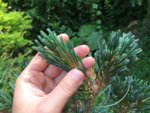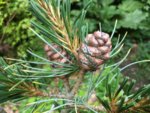Yah, yah. I want to see you do this kokonoe.
Seems so simple, but likely has so many traps. How many approach grafted roots do you need? I'm thinking 3 equally spaced around the trunk - but if one is wrong - yikes! maybe a dead tree. More approach grafted roots and it might be impossible to get enough auxin to pile up at the base of the koko to make koko roots grow.
Okay lets say 6 approach grafts. With these all as nicely functioning thunbergii roots, why would I try to put in on its own roots (by painstakingly removing one thurnbergii root at a time)? The traces/scars of the grafted thunbergii roots will be there for a long time afterward. The six probably would make a nice nebari, but then, how do you ever cut windows in between and separate it from the old root stock? We know of Owen's experience - why would you be so lucky after years of getting 6, say, approach grafted thunbergii roots established?
Seems to me that a new nebari on a juniper is a cake walk compared to what you are taking on.
But so what. You've got the tree. Let's get cracking!







